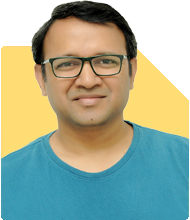49-Year-Old Aims for Retirement Fund - Can They Achieve 50 Lakhs by 60?
Ramalingam Kalirajan |8291 Answers |Ask -Follow
Mutual Funds, Financial Planning Expert - Answered on Jan 07, 2025
He has an MBA in finance from the University of Madras and is a certified financial planner.
He is the director and chief financial planner at Holistic Investment, a Chennai-based firm that offers financial planning and wealth management advice.... more

i am 49 years now. two years back i bought flat (15 years old) in heart of Hebbal Bangalore with all my savings 50K. I dont have any home loan/no personal loan/no hand loan/no credit card payment. my current take home salary is 70K. daughter studying 1st year engineering (her college expenses 1.5 lakhs/year) and my son 6th std (his school expense 1.5 lakhs including sports coaching). i am not doing any lavish expenses. After spending all my money to buy flat. Now my biggest worry is nearing retirement. I want to create retirement fund of min 50 lakhs by the age of 60. how can i achieve and advise some good funds and what strategy should i adopt.
Let’s create a 360-degree plan to achieve your target systematically.
Key Observations and Challenges
Educational Expenses: Annual expenses for your daughter and son total Rs. 3 lakhs.
Savings Potential: After meeting essential expenses, your ability to save is key for investments.
Time Horizon: You have 11 years to build a retirement corpus.
No Existing Investments: Starting now requires focused efforts and disciplined execution.
Monthly Savings and Investment Strategy
1. Determine Monthly Savings Capacity
Deduct all fixed and variable expenses from your take-home salary.
Aim to save at least Rs. 20,000 monthly for investments.
Any salary increments should directly increase your savings.
2. Adopt a Step-Up SIP Approach
Start with Rs. 20,000 monthly in Systematic Investment Plans (SIPs).
Increase your investment by 10% annually.
A step-up SIP ensures higher contributions over time.
3. Allocate Investments Across Fund Categories
Equity Mutual Funds: Allocate 70% of your monthly SIPs to equity funds.
Hybrid Funds: Invest 20% in balanced advantage or aggressive hybrid funds.
Debt Funds: Allocate 10% to debt funds for stability and emergencies.
Fund Selection Recommendations
Equity Funds
Focus on actively managed funds across large-cap, flexi-cap, and mid-cap categories.
Actively managed funds outperform in the long term compared to index funds.
Hybrid Funds
Hybrid funds dynamically adjust equity and debt allocation, reducing risk.
Suitable for those nearing retirement.
Debt Funds
Debt funds provide stability and liquidity.
Use them for short-term needs and goal realignment near retirement.
Tax Efficiency
Equity Mutual Funds: LTCG above Rs. 1.25 lakh is taxed at 12.5%.
Debt Funds: Both LTCG and STCG are taxed as per your income tax slab.
Plan redemptions to minimise tax liabilities.
Additional Financial Planning Tips
1. Emergency Fund
Build a reserve of at least 6 months’ expenses in liquid funds.
This ensures financial stability during unforeseen events.
2. Insurance
Ensure adequate health insurance for your family.
Avoid investment-linked insurance plans like ULIPs or endowment plans.
Term insurance can secure your family’s financial future.
3. Track and Review
Monitor your portfolio semi-annually.
Rebalance funds to maintain the right mix of equity and debt.
4. Children’s Education
Prioritise their education without compromising your retirement savings.
Plan for their higher education by partially using hybrid or debt funds.
Insights on Direct vs Regular Funds
Direct Funds
Managing direct funds needs expertise and time.
Most investors find it challenging to track fund performance.
Regular Funds via CFP
A Certified Financial Planner ensures personalised advice and goal alignment.
They provide a structured approach, helping you stay on track.
Regular funds also simplify taxation and rebalancing.
Steps to Implement
Open a SIP for Rs. 20,000 in mutual funds through an MFD associated with a CFP.
Gradually increase your SIP amount annually by 10%.
Diversify investments across equity, hybrid, and debt categories.
Create a dedicated retirement fund and avoid using it for other goals.
Periodically review and realign your portfolio with a professional.
Finally
Starting your retirement journey now is a wise decision. Discipline, consistency, and smart fund selection will help achieve your Rs. 50 lakh target. With careful planning and execution, you can secure a comfortable retirement while supporting your children’s education.
Best Regards,
K. Ramalingam, MBA, CFP,
Chief Financial Planner,
www.holisticinvestment.in
https://www.youtube.com/@HolisticInvestment
Best Regards,
K. Ramalingam, MBA, CFP,
Chief Financial Planner,
www.holisticinvestment.in
https://www.youtube.com/@HolisticInvestment
You may like to see similar questions and answers below
Ramalingam Kalirajan |8291 Answers |Ask -Follow
Mutual Funds, Financial Planning Expert - Answered on Jul 03, 2024
Ramalingam Kalirajan |8291 Answers |Ask -Follow
Mutual Funds, Financial Planning Expert - Answered on Jul 27, 2024
Ramalingam Kalirajan |8291 Answers |Ask -Follow
Mutual Funds, Financial Planning Expert - Answered on Jul 31, 2024
Ramalingam Kalirajan |8291 Answers |Ask -Follow
Mutual Funds, Financial Planning Expert - Answered on Feb 05, 2025
Dr Nagarajan Jsk |346 Answers |Ask -Follow
NEET, Medical, Pharmacy Careers - Answered on Apr 25, 2025
Nayagam P P |4463 Answers |Ask -Follow
Career Counsellor - Answered on Apr 25, 2025
Nayagam P P |4463 Answers |Ask -Follow
Career Counsellor - Answered on Apr 25, 2025
Nayagam P P |4463 Answers |Ask -Follow
Career Counsellor - Answered on Apr 25, 2025
Patrick Dsouza |1030 Answers |Ask -Follow
CAT, XAT, CMAT, CET Expert - Answered on Apr 25, 2025
Dr Dipankar Dutta |1168 Answers |Ask -Follow
Tech Careers and Skill Development Expert - Answered on Apr 25, 2025
Dr Dipankar Dutta |1168 Answers |Ask -Follow
Tech Careers and Skill Development Expert - Answered on Apr 25, 2025
Dr Dipankar Dutta |1168 Answers |Ask -Follow
Tech Careers and Skill Development Expert - Answered on Apr 25, 2025
Radheshyam Zanwar |1566 Answers |Ask -Follow
MHT-CET, IIT-JEE, NEET-UG Expert - Answered on Apr 25, 2025
Radheshyam Zanwar |1566 Answers |Ask -Follow
MHT-CET, IIT-JEE, NEET-UG Expert - Answered on Apr 25, 2025






















